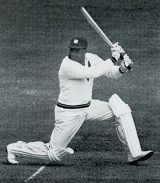Clyde Walcott
ESPNcricinfo staff
|
|

|
Walcott, the youngest of the triumvirate, made his debut for Barbados on his 16th birthday in 1942, the year after his brother Keith. Four years later, he made an unbeaten 314 against Trinidad, sharing an unbroken stand of 574 with Worrell, a world record at the time. But initially he was thought to be a lesser talent than the other Ws, possibly because, despite his size, he was also saddled with the wicketkeeping gloves. After a quiet start in Test cricket, he made 152 against India at Delhi in 1948-49.
On the seminal 1950 England tour it was Walcott's uncompromising, unbeaten 168 which set up West Indies' famous victory at Lord's: Wisden labelled his innings the turning point of the match. On the whole trip Walcott made 1,674 runs at 55.80, putting him eighth in the national averages but behind both the other Ws. Walcott also made 48 dismissals, including 18 stumpings, mostly off Sonny Ramadhin and Alf Valentine - he couldn't understand why the English batsmen had such trouble against Ramadhin's "mystery" spin, since he could pick him all the time - but also suffered the first bouts of back trouble which eventually forced him to give up the gloves. Soon Walcott was solely concentrating on his batting - and how. He warmed up for his golden spell with centuries in the last two Tests when India toured the Caribbean early in 1953. The following year he piled up 698 runs against England, his coruscating 220 at home at Bridgetown helping West Indies to a 2-0 lead. In that match, Walcott had to rescue the team from 25 for three. "He knew Hutton had to set an attacking field which left gaps in front of the wicket and he accepted the challenge with a counter-attack," wrote Alex Bannister in Cricket Cauldron. "How well he succeeded is history."
Then, in 1954-55, Walcott (who by now had moved to British Guiana) went up another gear. Against Australia he made five centuries in the series, including two in a match twice, on his way to 827 runs. West Indies, whose bowling was weak, still lost 3-0. Richie Benaud recalled: "I have never seen a more powerful batsman than Walcott, and when he was 'going', it was almost impossible to bowl a length to him." Walcott had a strange twirl in his backlift ("he sometimes took the bat forward in a semi-circle through mid-off before bringing it down with a full face to meet the ball," wrote Benaud) and he preferred to hang on the back foot, and club through the line. This sometimes found him out when the ball was moving - he failed in Australia in 1951-52 - but it worked well in the West Indies, where the ball usually deviated less. In those three home series, from 1952-53 to 1954-55, he made 1,982 runs at 82, with ten centuries.
The England all-rounder Trevor Bailey crossed swords with all the Ws many times. "Weekes was a small, neat, compact back-foot player," he wrote, "while Worrell was the most artistic and stylish. But of all three I found bowling to Clyde on a good wicket the most difficult and unremunerative. He had the ability to hit good-length deliveries with astonishing ferocity using a straight bat off both front and back foot." "Lord knows what he would do with a modern bat," said John Woodcock. Walcott toured England again on the unhappy 1957 trip. England romped to a 3-0 series victory, although Walcott became one of the Wisden Five (unusually, editor Hubert Preston had said in 1951 that he regretted not being able to find room for him).
He retired from Test cricket after Pakistan's tour of the West Indies early in 1958, but re-emerged briefly when England visited the Caribbean two years later. He ended with a Test batting average of 56.68, ahead of Worrell (49.48) but behind Weekes (58.61). Walcott then devoted himself to business, rising to become a director of a shipping company in Barbados, where he had returned at the start of the 1970s as the political climate in what was now Guyana worsened. He also moved smoothly into cricket administration, rising to the heights for which Worrell, who died of leukaemia in 1967, had seemed destined. Walcott managed several West Indian touring teams (in 1969, his first one in charge, he played, aged 43, in the infamous all-out 25 against Ireland), chaired the board and the selectors, and in 1993 became the first non-British chairman of the ICC. Politically, he was a transitional figure, taking the organisation calmly and emolliently from under the wing of MCC before it was taken over by leaders less wedded to traditional Anglophilia. Already an OBE, he was knighted in 1993 for services to cricket. He also received the Golden Arrow of Achievement from Guyana, and a Gold Crown of Merit for his immense contribution to cricket in the West Indies.

